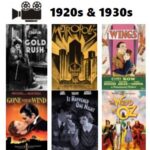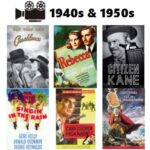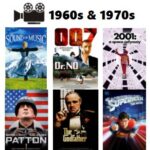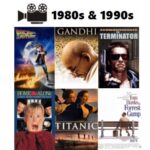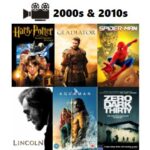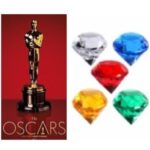Clicking on the following links or images will take you to the movie collections covered in this section:
Note: Click here to go to the Blogs, Posts & Forum section on English movies.
In this section, I have compiled a list of my favorite Hollywood movies (and a few non-Hollywood ones as well) for each year starting from the 1920s. Please note that this compilation is based on my personal criteria; however, I have found that my own tastes line up quite well with those of nearly all of my friends, so I hope that they will line up with yours as well!
Here are some of my selection criteria: (a) I should have personally watched any movie I have listed here. (b) I am not a fan of highbrow movies with stream-of-consciousness plots, angst-ridden characters and complicated relationships which don’t entertain but are simply a vehicle to demonstrate the filmmakers’ virtuosity. (c) My preference is for movies in which the director keeps the story moving and makes you wonder what comes next.
I have marked with a GEM symbol those movies I consider the “best of the best” (GEM = Genuine Masterpiece). Of course, these selections are entirely subjective, but as I have found that my tastes match quite well with a majority of people I am sure most of you will find these movies to be enjoyable as well. If you have any suggestions on additions or deletions, please share them using the Comments/Suggestions form.
I have segmented the movie lists by the decades in which the movies were released. In addition, I have identified a set of standout actors, actresses and directors whom I consider to be luminaries, and I have compiled specific lists of their respective bodies of work. Since I have always been a fan of thrillers, I have also created a special list of movies which fall in this category, along with other genres. Next, there are some memorable roles by performers who will always be identified with those roles, my list of these is again based on my own (subjective) judgment. Finally, I have made a list of top films based on two separate criteria: (a) movies I have classified as GEMs based on my personal criteria, and (b) movies which won the Academy Awards for best film, best director, best actor or best actress.
A Brief History of Hollywood Movies
Here, I share my perspective on the different phases of the development of Hollywood films (and a few others made elsewhere), from the 1920s to the present day. In my view, the evolution of Hollywood films can be divided into five different eras, as listed below.
(a) Studio Era (1930s & earlier): During this era, movie-making was run as a vertically-integrated business by the major studios which kept thousands of people on salary and owned the real estate where the movies were filmed as well as the theaters where the movies were screened. The era started with black-and-white silent movies, but color became more prevalent in the late 1930s. Many breakthroughs were made during this period, such as synchronized sound (The Jazz Singer) and feature-length animation (Snow White and the Seven Dwarfs). The studio era reached its pinnacle in 1939 with releases such as Gone with the Wind, Mr. Smith Goes to Washington and The Wizard of Oz.
(b) Post-Studio Era (1940s & 1950s): In the 1940s, the studio system started to wane, and independent filmmakers began to emerge. The studios started to release actors and technical staff from their contracts, which gave them free rein to exercise their independence and creativity. This changed the paradigm of film-making, as each movie could have an entirely different cast and production team. This was very liberating to the creative talent in the movie industry, and as a result some of the greatest Hollywood movies were made during this era, such as Casablanca, Singin’ in the Rain and The Bridge on the River Kwai.
(c) New Hollywood (1960s & 1970s): This period is also known as the “American new wave” or “post-classical cinema” and marked the changing methods of storytelling in Hollywood, such as scrambled chronology, “twist endings” and the lines between protagonist and antagonist being blurred. A new generation of young filmmakers such as Stanley Kubrick, Steven Spielberg, George Lucas and Martin Scorsese came into prominence. They had a strong influence on the types of films produced as well as their production and marketing. Some classics from this era are Psycho, 2001: A Space Odyssey, The Godfather and Star Wars.
(d) Home Video Era (1980s & 1990s): This period saw another significant development: availability of motion pictures on videotape or DVD. Films which performed poorly in their theatrical run sometimes found success in the video market. DVDs provided an additional revenue stream to movie-makers and often included extra scenes, extended versions and commentaries. Some other trends which started in this era were movie franchises such as Star Wars and Star Trek (sci-fi/fantasy), Superman and Batman (super-hero), and Die Hard and Terminator (action). Among the prominent directors who emerged in this era were James Cameron, Ron Howard, Ridley Scott, Oliver Stone, Rob Reiner and Quentin Tarantino.
(e) Modern Era (2000s & beyond): The early 2000s ushered in a new model of watching movies which was pioneered by Netflix: renting DVDs by mail as a monthly service. Eventually, this transitioned to a streaming service by Netflix and others (Amazon Prime, Disney+, etc.), and streaming has now become an alternative way of viewing movies vs. watching them in theaters. This paradigm shift has blurred the boundaries between films, television and other forms of media, and many movies (especially indie films) nowadays completely bypass theatrical release and go directly to streaming. However, super-hero films, which have become a dominant force at the box office, continue to follow a hybrid model (theaters + streaming) with blockbuster franchises such as X-Men, The Dark Knight, Spider-Man and The Avengers.
Reference: https://en.wikipedia.org/wiki/Cinema_of_the_United_States

